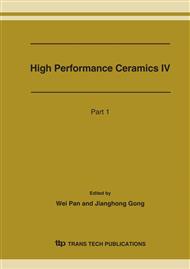p.2569
p.2572
p.2575
p.2579
p.2583
p.2586
p.2589
p.2592
p.2595
Microstructure and Mechanical Properties of Freeze Cast Alumina/Silicon Carbide Layered Composites
Abstract:
Symmetric three-layer composites prepared by sintering freeze cast compacts of alumina with additions of nanoparticle/whisker SiC, in 1-atm nitrogen at 1700-1800oC have been characterized in terms of microstructure and mechanical properties. Additions of SiC to Al2O3 result in improvement in toughness. In such cases, however, the reduction in strength at small flaw sizes must be overcome. Contact damage resistance is greatly increased in layered composites compared with monolithic composites, possibly due to redirection of indentation flaws along the layer interface.
Info:
Periodical:
Pages:
2583-2585
Citation:
Online since:
April 2007
Price:
Сopyright:
© 2007 Trans Tech Publications Ltd. All Rights Reserved
Share:
Citation:


